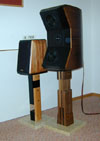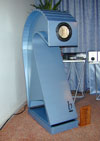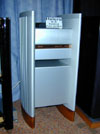 |
It is now my third consecutive year that I'm attending the Show which takes place at Novotel in Hammersmith, London. As always, it is organized by the British Hi-Fi News magazine. I visited the show on both 13 and 14 September 2001.Please read my below commentaries having the following in mind:
- Due to the adverse acoustical (and other) conditions of the shows, this is not an absolute review but just my impressions.
- I only covered the rooms which seemed either original, interesting or had a new product.
- I automatically skipped all rooms with a screen (white or plasma) between the two speakers.
- The order of visits is totally random. And the same
randomness is reflected in the below report.
I always tried to evaluate the systems using my own CD's which were:
- R. Strauss / Violin Sonatas / Chung, Zimerman / DG427 617-2
- Keith Jarrett Trio / Bye Bye Blackbird / ECM 1467 513 074-2
- Shostakovich / Symphony No.8 / Concertgebouw, Haitink / Decca 411 616-2
- Saint-Saens / Symphony No.3 / BPO, Levine / DG 419 617-2
- Rickie Lee Jones / It's Like This / Artemis 751 054-2
I was listening to systems and not to components and therefore, if my impressions are favourable, this may indicate that either all the components are sounding good or the synergy is good. In the opposite case, either one or more components are causing it or the synergy is poor. Speaker positioning and room treatment are also extremely important.
Let me also make a general comment about this year's show. Using the hi-fi terminology, in two words: dull and uninvolving. There were fewer attendants, fewer visitors, more home theater. Exhibitors chose to display their lower range components instead of the flagship ones. Also due to the tragic event which had happened only two days before general morale was very low and many US citizens could not attend the show. Still I saw the light in all this darkness and it was a very bright one: the promise of even clearer days for the future of high-end audio. An industry secret is partly revealed to me (yes, exclusively to me). So, do not be discouraged by my earlier words, just read on and discover….
click images to enlarge
|
|
Here the system was composed of the following main components:
Celius was Triangle's recently launched model. Its efficiency is 92 dB/W/m and its UK retail price 1,250 Sterling. The sound was natural and detailed but the bass lacked slam and extension. It also seemed as if the system was not properly tuned. Although it is difficult to isolate it from the rest of the system, I still think that Triangle's new speaker has lots of potential. |
|
|
This year ProAc chose to present the smallest (and recently introduced) speaker of their Future series: the Point Five. They were driven by Primare Solid State electronics. Although Mr. Stuart Tylor (the designer and the owner of ProAc, see picture below) informed me that the speakers were only two days old, the sound was very natural and had a near perfect tonal balance. The body of the mids and the bass extension were very good in spite of the relatively small size of the speakers. The sound stage dimensions were very satisfactory and the overall sound was very musical indeed (am I biased or what?). More can be expected once they are properly broken-in. This is one of the good sounds of the show. |
|
|
This year UK distributor Audiofreaks were featuring Avalon Eclipse speakers driven by KARAN solid state amplifier (a new name to me). The rest of the electronics were Muse Thalia Nine CD player and Conrad Johnson Premier 18 LS preamp. During the past two years Audiofreaks room was the best tuned one and I remember having heard there one of the best sounds of the show. Unfortunately this year's system sounded dull, lifeless and slightly veiled. Compared to previous years the main change is the power amp (Karan instead of Conrad Johnson), so one is immediately tempted to point the finger at the new power amp as the cause of such degradation. But the reason could as well be a component not properly broken-in. |
|
|
During my previous visits I wasn't so much impressed by the sound of the Loth X rooms. This time they were displaying different designs, so I was curious to hear if there were any major changes. The drivers used in the Loth X Polaris speakers are similar to Lowthers. Here they are called Stamm (the name of their designer). The Single Ended 300B power amp was also made by Loth X and it was called JE 300. Croft Absolut 1 preamp was used. As a plus I can say that the sound was very alive, but at the same time it seemed a little forward and tiring. Tonality was natural but the sound was not dynamic enough. |
|
|
Usher is a Taiwanese company manufacturing speakers and amplifiers. The reference 6 power amplifier was rated 120W/channel (it supports 6 channels in total). The retail price of this amp is said to be $1,350.-. Model 777 and the other speakers present in the room looked like modified imitations of Sonus Faber designs (see pictures). The drivers looked like ScanSpeak but they were also Taiwan made. Let me tell you that the sound was very decent and natural but still slightly electronic. The bass was not too extended. But overall a good result if you keep in mind their relatively low selling prices. |
|
|
Rethm is a new speaker brand (at least to me). The displayed model is called Second and has a modified Lowther DX-4 driver. As with all Lowther speakers its efficiency is on the very high side: 102 dB/W/m. It was somehow astonishing (or revolting) to notice that all the electronics were solid state DNM. I have nothing against the brand but such high efficiency speaker is an ideal companion for low power Single Ended triode amplifiers. The speaker's designer agreed with me but for some reason (unknown to me) they had to share the room with DNM. So be it! The sound was natural but dry and lean. And the bass was not extended enough. My guess is that the result could have been much different if a decent Single ended amp was used. |
|
|
Beauhorn room was featuring their new lower range B2 speakers. Beauhorn's top range Virtuoso's are my favorite commercial speakers using Lowther drivers. The new B2's are fitted with Fostex drivers instead of Lowther DX-4. The amps and preamps are single ended and custom made by Beauhorn. B2's were also very musical like the Virtuoso's and the tonality was on the warm side. Perhaps a bit too warm and thick. I also noticed that the speaker was missing the inner detail and the delicacy of the Virtuoso's. If you haven't heard the Virtuoso's and you liked the B2's, then don't listen to Virtuoso's because their price is nearly the double of B2's (but they are 100% worth it). |
|
|
Eyris 1 is Tannoy's new small speaker. Its tweeter is in fact a supertweeter with a response curve extending up to 44 kHz. UK retail price is 499.- Sterling/pair. They were driven by Canada made Moon electronics (a new name to me). Contrarily to Tannoy's big top range speakers Eyris 1's sound was neutral. Although not much extended (which is perfectly normal for such a small size speaker), the bass had weight, slam and definition. With pop music and small trios the result was very satisfactory, whereas on dynamic passages of classical music they became slightly aggressive. Such behavior may also be due to the electronics. I'm sure that with a proper tuning and a better front end the performance of these tiny speakers can be raised to a higher level. |
|
|
Again this happened to be the show's most interesting room. Plus I had the honor of being the first confidant for a quasi-revelation of a secret project that is claimed to be revolutionary. So read on. But let me first list the system's components in detail.
This year the only major change was the power amps: solid state Halcro had replaced Convergent Audio's push-pull tube amplifier. Halcro's are made in Australia, 200W/channel, 24,000.- Sterling/pair (!) monoblocks. Their British distributor claimed that although solid state Halcro's have a "tube sound". They have a have also a striking look and finish. As the Accapella speakers and their plasma tweeters were fully covered in my London 2000 report, I do not wish to repeat myself here. If you are interested (you should be), please read my previous report. This time there was also a CD player: Burmester 001. I was glad to have the opportunity to also listen to my own CD's and thus better evaluate the system's performance. I can easily state that this system had the best sound of the show. It was natural, musical, detailed, extended, dynamic,…., you name it. Of course LP had a better, more liquid sound. Although the Burmester 001 is not the very best of its kind CD performance was very decent too. The bass definition on the first track of Rickie Lee Jones'"It's Like This" album was exemplary: truly amazing. Yes, I guess Halcro power amps had the claimed "tube sound": they did not seem to have any negative contribution to the overall synergy of the system. Now I guess the time has come to share with you the "top secret" revelation of Mr. Peter Suchy, the owner and designer of Clearaudio. It was his will that I communicate it to my readers, and said that it is the first time that he talks about it to someone outside the company. Of course he did not want to reveal the project fully as it was secret, but gave me some hints about it. He said that the new project will be "independent of any format". It will both serve the digital and the analog formats (not necessarily in this order) and will completely change the high-end industry. It will be far better than anything we know and we can imagine. Than I started to try to solve this puzzle and tried to make a guess. "Will this be an upsampling digital preamp which will accept both analogue and digital sources?" I ventured. Well apparently I wasn't too far. "Yes, something like that" he said "but with much higher sampling frequencies". He told me what the sampling frequency was but asked me not to write it. I can only confirm that it is indeed a very high (way above than used today by any brand) sampling frequency. The launch of the product is foreseen for mid 2002. The first product will serve the analogue source, than the following years more features will be added to include digital sources. On the bottom picture you van see Mr. Suchy's enthusiasm while talking about his new project. He was also very confident regarding its future and unprecedented success. This is probably the best news of the show: at least someone is working hard for the future of high-end audio. |
|
|
I listened to Renaissance's new RA-1 push-pull 300B monoblocks through Wilson Benesch ARC-1 small speakers. Other components were Marantz CD player and Passion passive volume control unit. I think that small speakers are a wrong choice to reveal the capabilities of a power amp as they can't give you a correct idea about the amp's ability to handle the low frequencies. Nevertheless the sound was natural and detailed. But no bass no emotions (who said that?). |
|
|
The system consisted of:
The first introduction of Wilson Benesch Dicovery speakers was made during London 2000 show and it took place in the Chord room (see my report). My impressions were very favorable. This year they are driven by Lamm amplification and I think the result is again very good. The sound is natural and detailed. There is also an involving musicality and liquidity that is not always present in most systems. The low frequency performance is very satisfactory. A shade more warmth would be ideal to my taste. I think this is one of the few good sounds of the show. |
|
|
Art Impression speakers were driven by Sugden Masterclass electronics. The sound was natural but seemed a little boxy and compressed. It was a bit dull too. Maybe it's because the two brands are not a match made in heaven. |
|
|
I think that Naim's software department surpassed their hardware division: they produce top class audiophile grade recordings. Not only the recording quality is outstanding, there is also musical substance. I already played some of their CD's in my radio program and will continue to do so in the future. If you never bought a Naim CD I recommend that you start with Antonio Forcione & Sabina Sciubba's "Meet Me in London" album. I'm sure you will not be disillusioned. The lady on the left is the Naim brand manager Anna Tooth. |























